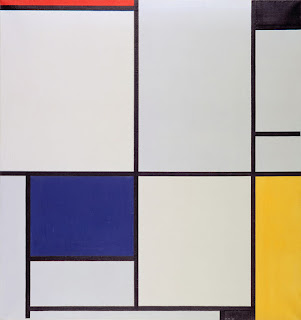 |
Schröder House, Gerrit Rietveld, 1924. Utrecht, Netherlands.
|
 |
| Barcelona Pavillon, Mies van der Rohe, 1929. |
 |
| Interior of Barcelona Pavillon, Mies van der Rohe, 1929. |
 |
| Schindler House Interior, Rudolf Schindler, 1922, West Hollywood,CA. |
 |
Schindler House, Rudolf Schindler, 1922, West Hollywood,CA. |
Around Los Angeles, the white Beach House style has a larger more modern version that is perched on the steep slopes of the hills and canyons. The earliest was arguably the Lovell House, designed by Richard Neutra and built from 1927–1929. Neutra attended the Vienna University of Technology and worked with Frank Lloyd Wright and later with his friend and future competitor, Rudolf Schindler. Neutra and his family occupied one of the apartments of the Schindler House while Rudolf Schindler and his wife occupied the other.
 |
Lovell House, Richard Neutra, 1929. Los Angeles |
 |
Case Study House #22, Los Angeles, 1960. Pierre
Koenig, Architect. Photograph, 1960, Julius Shulman.
|
If the Stahl House looks familiar. it might be because about a dozen movies or TV episodes have been filmed there.
So how is it that these homes look so similar despite the different countries – Bauhaus in Germany, De Stijl in the Netherlands, two Viennese architects living in Los Angeles during the1920's, and an American architect more than a generation later?
In 1932 the Museum of Modern Art, in New York (MoMA), had an exhibit Modern Architecture: International Exhibition. The title of the catalogue for the exhibit was published as The International Style: Architecture Since 1922. The foreword of the exhibition catalogue gave clarity about this previously unnamed style.
The present exhibition is an assertion that the confusion of the past forty years, or rather of the past century, may shortly come to an end. Ten years ago the Chicago Tribune competition brought forth almost as many different styles as there were projects. Since then the ideas of a number of progressive architects have converged to form a genuinely new style which is rapidly spreading throughout the world..... Because of its simultaneous development in several different countries and because of its world-wide distribution it has been called the International Style.
The exhibit, curated by historian Henry-Russell Hitchcock and architect Philip Johnson was the first architectural exhibit at MoMA. Elements of the new style – emphasis of volume over mass, geometric regularity and repetitive modules, no ornamentation, lightweight mass-produced, industrial materials were discussed in the catalogue. It was unusual for an institution to name and codify a style. Previously it was the writings, often derogatory, of art critics that named new styles.














































